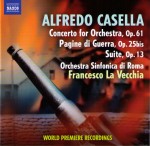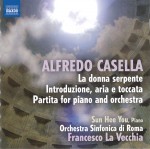
 Alfredo Casella – Concerto for Orchestra
Alfredo Casella – Concerto for Orchestra
Orchestra Sinfonica di Roma; Francesco La Vecchia
Naxos 8.573004
Alfredo Casella – La Donna Serpente; Introduzione, aria e toccata; Partita
Sun Hee You; Orchestra Sinfonica di Roma; Francesco La Vecchia
Naxos 8.573005
These two discs present world premiere recordings (except for the Partita) of Alfredo Casella’s music. They join a series of his complete orchestral works on Naxos, a stellar accomplishment by conductor Francesco La Vecchia and the Rome Symphony Orchestra. Piano prodigy and gifted conductor, Casella (1883-1947) was a leading instrumental composer in opera-soaked Italy.
The excellent first disc includes music from three phases of Casella’s career. Modal harmony and 18th century dance genres in the early neo-classical Suite reflecthis teacher Fauré’s influence. The lively Overture, pensive extended Sarabande, and assertive Bourée are all delivered impeccably by the Rome Symphony. The ensemble is equally adept in the more adventurous five miniatures of Pagine di Guerra (War Pages). Startling sounds bombard us with the mechanical horror of World War I; perfectly-tuned wind chords subtly evoke dissonant cathedral bell timbres. The three-movement Concerto for Orchestra is the disc’shighlight, which according to David Gallagher’s fine program notes Casella considered his most mature orchestral achievement. Particularly moving is the epiphanic ninth variation of the Passacaglia where high violins linger deliciously over a procession of brass and wind solos.
The second disc’s Introduction, Aria and Toccata has both strengths and weaknesses. His easy way with a long line make the Aria a delight; La Vecchia captures its tasteful sentiment and tender moments.Strings are appropriately biting in the outer movements, which unfortunately also illustrate the composer’s penchant for lumpy Mussolini-era marches. Casella was piano soloist in the premiere of the Partita in 1925, where Stravinsky’s neo-baroque influence shows. In the Sinfonia, pandiatonicism (simultaneous sounding of any notes in a major scale), prominent use of winds and detaché strings are all Stravinskian, but rhythms are more four-square. Pianist Sun Hee You delivers a clear, spiky performance with impeccable ensemble throughout; the orchestra’s trumpet trio shines in the rapid-fire Burlesca. La donna serpente (1928-31) which presents orchestral fragments from Casella’s opera based on a fabulous drama about a snake-woman by Gozzi, evokes a very different world. From the sumptuous strings in the opening Music for King Altidòr’s Dream onward, La Vecchia balances well blocks of orchestral sound with instrumental solos. The War March showcases a fine horn section; the Battle and Finale abounds with exciting ensemble flourishes supported by ample percussion.
The neglect of Casella’s orchestral music after the Second World War had several possible causes: his troubling support for Il Duce’s regime even after racial laws were imposed in 1938; his too-numerous musical influences; and his re-working of compositions in later works. Keeping these important caveats in mind I am still very partial to this music’s bright liveliness and range of feeling, recommending especially the first disc for the curious.



